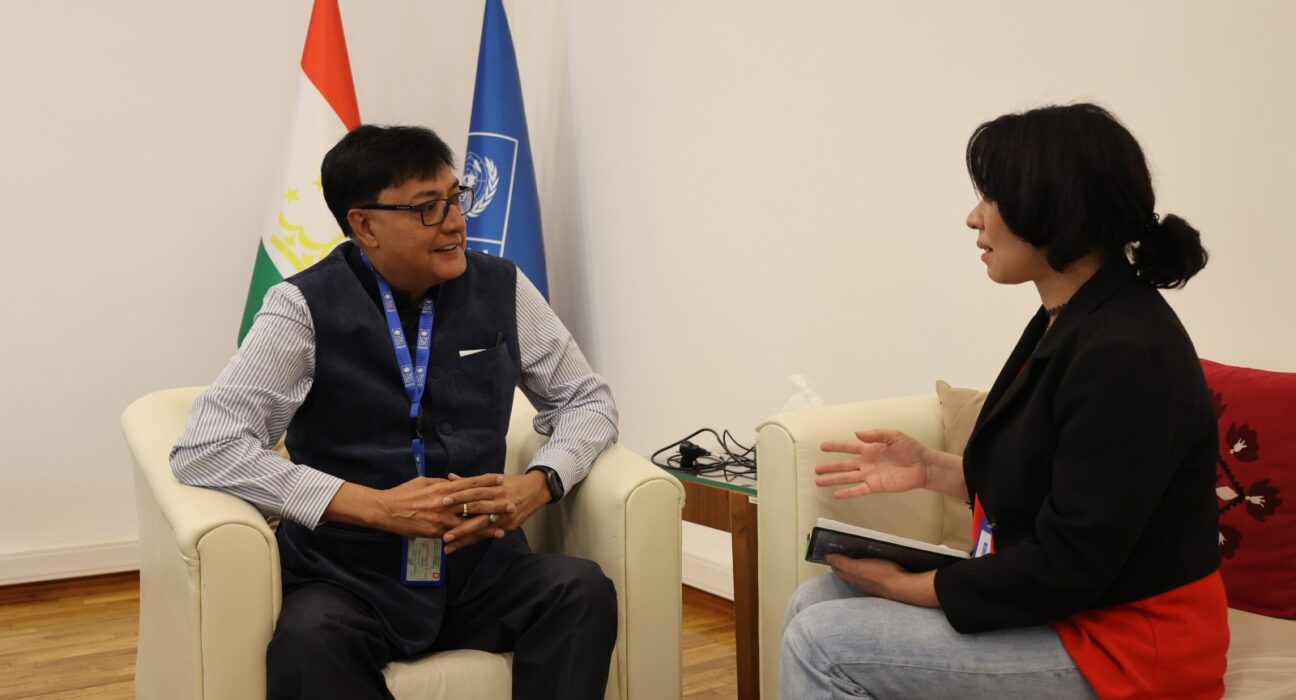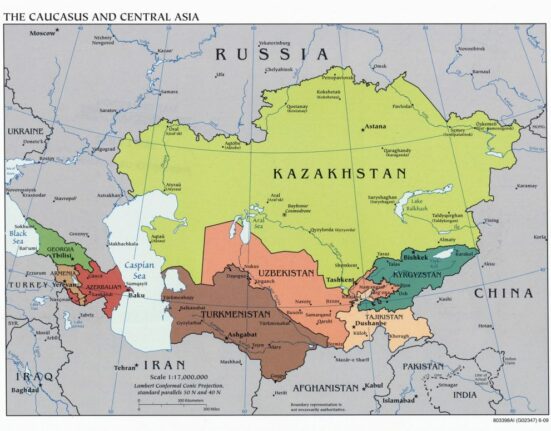In his first interview in Dushanbe, Sudipto Mukerjee, Resident Representative of the United Nations Development Programme (UNDP) in Tajikistan, spoke with journalist Shoira Toirova about how the country’s development priorities are changing, why young people are becoming a key factor of sustainability, and how innovation, climate adaptation, and local solutions are shaping the region’s future.
“In every country, I remember my first conversations”
— Mr. Mukerjee, this is your first interview in Tajikistan. How does one begin getting to know a new country and its context?
— First of all, this interview is special for me because it’s the first one I’m giving in my new assignment. I have been in Tajikistan for only three and a half months — too short a time to fully understand any country. Everything I say now is based on a very limited exposure. Yet even within this short period, I have felt that the country has very good development, especially in its human capital.
“UNDP always responds to the needs of the moment”
— This year, UNDP marks 32 years of presence in Tajikistan. Looking back on this journey, what do you consider its key achievements?
— Over the past 32 years, the organization has completely transformed its approaches several times. After the civil war, Tajikistan needed recovery and peace. At that time, UNDP helped lay the foundations for stability. Today, the country is confidently moving toward middle-income status, setting ambitious goals—to become energy independent, to rely 100% on renewable energy, and to develop a digital economy and artificial intelligence.
That’s why it’s impossible to single out specific achievements. UNDP always responds to the needs of the time. When any country faces hunger—food security must be ensured. When it confronts climate risks—adaptation must be supported. We are a flexible structure, moving in step with the country we are mandated to serve.
Three priorities: youth, energy, and climate
— What priorities do you consider key for Tajikistan today?
— I wouldn’t rank them in order of importance, but I would highlight three directions.
The first is working with youth. Tajikistan is one of the youngest countries in the region: almost 70% of its population is under 35. This is a huge resource, but also a challenge. Young people need education, jobs, and opportunities to reach their full development potential and ideally at home.
The second direction is energy. Yes, Tajikistan is strong in renewable energy, especially hydropower. At the same time, given the impact of climate change on water resources, we need to simultaneously look to diversifying energy sources such as solar and biogas.
The third priority is climate change. Central Asia is warming faster than most regions of the planet. Today there are around thirty extremely hot days per year, but this figure may double soon. For Tajikistan, where 93% of the territory is mountainous, this is not just an environmental issue but a matter of survival. Accelerated glacier melt can lead to catastrophic floods and water shortages, directly affecting energy, agriculture, and people’s lives.
“Tajikistan contributes little to climate change but suffers more than others”
— At the same time, Tajikistan’s contribution to global warming is minimal…
— Absolutely. According to my data, Tajikistan’s share in global emissions is about 0.04%. That’s a tiny figure. The country hardly contributes to climate change but suffers from its consequences more than many industrialized nations. That’s why adaptation — rather than emission reduction — is the top priority here.
“We must learn to do more with less”
— The world is experiencing a crisis of international development financing. How does this affect UNDP’s work in Tajikistan?
— If we look at the past decade, a lot has changed. The year 2015 was historic: the world adopted three landmark agreements — the 2030 Agenda for Sustainable Development, the Paris Climate Agreement, and the Addis Ababa Conference on Financing for Development. It seemed the world was united around a common goal.
Then came COVID-19, which literally stole three years from us. After that — wars, which shifted global priorities. Many traditional Donor countries, not only have reduced their aid budgets: from 0.7% of GDP much less but even where maintained at 0.7% actual allocations are lower due to GDP shrinkages. All this means one thing: there are fewer resources for development while needs continue to grow. That’s why UNDP must learn to do more with less. We focus on innovation — how to grow more food with less water, how to create jobs in a “smart” economy, how to develop energy without harming nature.
We also emphasize co-financing. If five countries apply for the same grant, the one that contributes its own resources will have a definite advantage. I always stress: domestic investment is the key to sustainability.
Biogas: energy, ecology, and women’s health
— One of the most effective practical solutions is your biogas project. Could you tell us more about it?
— Biogas is a technology that’s more than a century old. Interestingly, the first experiments were carried out in this region, during the Persian Empire. Today we apply the same idea using modern equipment.
Simply put, farms can convert animal waste into clean energy. Just two cows can provide a household of six people with clean energy for daily needs. This is particularly important for remote villages not connected to the grid.
Biogas addresses multiple challenges at once. It reduces household expenses, cuts air pollution, and improves the health of women and children. The byproduct can be used as organic fertilizer. It’s a closed cycle — energy, food, and environment in one system.
Pilot projects have shown excellent results. If scaled up, the cost of installations will drop significantly. We hope to expand the program with support from the Ministry of Agriculture and international partners.
“When women work in justice, society becomes fairer”
— Gender equality is an important focus for UNDP. How do you assess the situation in Tajikistan?
— Gender inequality is a universal problem. Before the pandemic, it was estimated that achieving gender equality would take 220 years. After COVID, that number increased to 300. This is a global trend.
In Tajikistan, cultural and social barriers deepen the gap. When men migrate for work, women have to carry the full burden of the household — becoming both providers and caretakers. At the same time, their attainments in both paid work or education have room for improvement.
Together with the Government, we are trying to address this systemically. For instance, our internship programs require that at least 60% of participants are women. This creates real opportunities for employment within the country.
Another direction is promoting women in the legal sector. We support young female lawyers because when women work in justice, other women gain wider access to legal protection.
Even our biogas project is, at its core, gender-focused: it saves women time, reduces physical strain, and allows them to pursue education, business, and childcare.
“Every city should grow within its capacity”
— In Tajikistan, there’s growing talk about “new urbanism” and digitalization. You yourself are trained as an architect and urban planner. How do you see the development of Tajik cities?
— I haven’t seen much yet, but even from limited observation it’s clear: Dushanbe is growing faster than any other city. It’s natural for a capital — investments flow here, migrants return, opportunities concentrate.
At the same time, when any city grows too fast, urban planning and management can help to address problems that may arise in the future such as housing becoming more expensive, increased traffic, stress on infrastructure. Everything risks becoming costlier — even waste disposal, since the distance to landfills increases.
We could look at ways to balanced expansion of all cities to reduce urbanization pressures, with each city’s growth being planned within its carrying capacity — how many people it can support with water, energy, transport, schools, and hospitals.
It’s also important to advance the concept of “smart cities.” Dushanbe already has such initiatives, but they can now be extended to all other cities noting that digitalization, energy efficiency, and environmental responsibility are no longer seen as luxuries but as necessities.
Transparency, accountability, and “localization”
— I’d like to touch on another sensitive topic — transparency and corruption. In your view, how can such risks be minimized in project implementation?
— For several years now, UNDP has consistently ranked as the most transparent organization in international development. All our reports, audits, and financial data are publicly available on the UNDP website. Anyone anywhere in the world can see how projects are implemented and how funds are spent. This is a core principle.
In addition, all our processes — procurement, tenders, recruitment — are carried out through competitive procedures. Procurement is conducted via electronic systems (e-procurement), open to all bidders. The higher the competition, the lower the risk of corruption.
Before transferring funds to partners, we conduct thorough assessments, usually performed by independent audit or consulting firms. They evaluate whether a partner has reliable financial systems, the ability to plan, use, and report funds properly. After all, the root of most corruption cases lies in system gaps that allow mismanagement of money.
We also promote community monitoring. For instance, if biogas plants are being built under a UNDP project, the local community knows how much funding was allocated, how many installations were planned, and who is responsible. And if four are built instead of five, people have the right to ask why. This builds a culture of accountability rather than fear.
Every donor, when giving money to UNDP, is effectively transferring taxpayers’ money from their own country. We must account for every dollar spent. Failure to do so would damage not only our reputation but also trust — and consequently, funding. That’s why we undergo multiple external audits every year, and all results are published publicly.
“Localization is the future of international cooperation”
— In many international organizations, funds often pass through several intermediaries before reaching beneficiaries. Doesn’t that reduce efficiency?
— You’ve raised a very important question. In 2019, the World Humanitarian Summit in Istanbul discussed an initiative called the Grand Bargain. It emerged in response to the growing number of humanitarian crises — look at what’s happening in Gaza, Sudan, Yemen, Haiti, Ukraine. Needs are increasing, but resources are shrinking.
The issue is that many crises are becoming protracted. I was in Bangladesh in 2017 when Rohingya refugees began arriving from Myanmar. Back then, it seemed temporary. Today, in 2025, more than one million Rohingya still remain there. The same is true elsewhere.
In such circumstances, the global community realized the importance of localization — engaging local organizations, communities, and NGOs because they understand the context better and operate more efficiently. Of course, this can’t be done overnight. We must transfer capacities, knowledge, and strengthen their management systems.
Gradually, this is happening. More of our projects are now implemented through local NGOs to build their capacity and ensure that more resources reach the final beneficiaries.
— So emphasizing localization also makes aid more effective?
— Exactly. It’s both more effective and more equitable. Even within the UNDP country office itself, you can see the shift. Ten years ago, there were many more international staff. Today, there are only three international positions — mine, the deputy representative, and the head of operations. All others are local professionals.
This is not just about saving money — it’s recognition that Tajikistan produces world-class experts who meet international standards. Over time, as processes become fully localized, you’ll see the result yourself — more resources reaching directly those for whom the projects exist.




